3rd research report by Heinz Axthelm, 1938.
The heraldic foundations of the coats of arms of the Axthelm family are historically examined.
-
What is said about the Axthelm coat of arms and their origins.
-
The common feature of all these coats of arms.
-
Explanation of the errors based on individual coats of arms (a critique).
-
On the coat of arms of the “Axthelm family in 1590”.
-
The misleading nature of the coat of arms of the Silesian noble family von Axleben
-
The coat of arms of the chief forester Axthelm.
-
The coat of arms of the Bavarian noble line von Axthelm.
-
-
The new coat of arms
-
Basic questions about the adoption of the coat of arms.
-
Representation of the new coat of arms.
-
-
Authorization to use the new coat of arms.
-
What is said about the Axthelm coat of arms and its origins.
For generations, obscure rumors have circulated among the Axthelm families about a coat of arms that is supposed to bear the final, mysterious testimony to the supposedly legendary past and glorious beginnings of our line. Signet rings of various kinds, from the sensible to the fantastical, are found here and there. The strange thing is that no one can say exactly where such a ring originated or who the first seal holder was. It was made somewhere and at some point in time. In addition, various coats of arms sketches exist, even “beautifully” colored ones; some were also created for the owners by so-called heraldic painters for varying amounts of money. Furthermore, there are oral traditions about an alleged coat of arms. For example, there is a claim that a book in novel form exists that deals with the “life and fate of the von Axthelm family” during the Thirty Years’ War in the Margraviate of Brandenburg and contains a printed coat of arms of this family. I searched for this legendary book in various libraries and couldn’t find anything like it, even in the German State Library in Berlin and the German Library in Leipzig. This book is therefore—like so many other things, unfortunately!—a legendary product of the vivid imagination of our race. It’s now time to seriously put an end to such myths.
The only genuine and legally acquired coat of arms is the coat of arms of the Bavarian noble line of Axthelm, already mentioned in Reports I and II.
-
What all these coats of arms have in common
[…] is the diagonal left bar in the coat of arms, which appears partly gold, partly yellow. The most conflicting and impossible rumors have been circulated about this, too, one of which I almost believed. Years ago, a family researcher who was also somewhat interested in heraldry explained to me this diagonal left bar (i.e. a bar running through the coat of arms from top right to bottom left ) as a so-called bastard thread and claimed that our line dates back to the earliest times of chivalry, namely that a noble knight fathered an illegitimate son with a commoner girl, who inherited neither the property nor the noble title of his illegitimate father, but did inherit the coat of arms. However, the coat of arms was crossed out. This line, this bar, is therefore the so-called bastard thread, which shows that our line descended from a bastard.
That this interpretation, which struck me as oddly romantic, soon turned out to be a more or less beautiful horror story is of great importance to me, given the humble origins of our family as farmers and artisans.
Whether the idea of a connection between the formerly bourgeois line ( on the male side ) and the noble line ( on the female side ) played a role in the design of the coat of arms of the Bavarian noble family von Axthelm is certainly possible, but then in the best sense. Furthermore, the union of Johann Andrä ( see Report 1 ) with the noble Fräulein von Krashan was a completely legal one, so that one can never speak of bastardization.
In relation to our civic name, this diagonal left bar is nothing more than the suggestion of an axe handle, in keeping with the etymological meaning of the name (see Report 2 ). That is the crucial point. It is, however, very interesting that all these coat-of-arms fantasies, some of which were completely unfounded, are similar in the core element of the coat of arms, namely the shield. I attribute this to the fact that their respective makers found the seal of the Bavarian noble line (included in the nobility register in 1814, see Report 1 ) in their coat-of-arms collections and constructed a more or less false coat of arms based on it.
The best evidence of such imaginary constructions is the production of the coat of arms described under point 3a, which the company—or rather the so-called Berthold Grosskopf coat of arms factory in Karlsruhe im Breisgau —undertook. It is unbelievable how irresponsibly such bunglers hung a kitschy coat of arms on gullible people for considerable sums of money. [see Wikipedia article “heraldic fraud”]
In no other branch of history has so much been falsified and falsified as in heraldry (the study of coats of arms). Considering that heraldry is one of the most important auxiliary sciences of history, the responsibility in this field is all the greater the more historical clarification one expects from it. Determining which family a particular coat of arms, discovered somewhere, belongs to is one of the most difficult tasks in scientific heraldry. Therefore, identifying coats of arms is a matter of great experience and practice on the part of heraldic experts, who often only reach a reliable result with the help of genealogical or other findings. General tools for identifying coats of arms exist only rarely. In many cases, collections of coats of arms are a last resort, since even the most experienced heraldist cannot know all coats of arms. In any case, it would never occur to a “real” herald to present the coat of arms of an ennobled line in a stylistically impossible manner and with a fanciful description to a bourgeois family of the same name, as the Karlsruhe-based company Grosskopf unfortunately did.
-
The explanation of the error based on the individual coats of arms.
This part of the report is intended to provide a detailed overview of the four main forms, but also to offer a factual, historical critique.
a) About the coat of arms of the “Axthelm family in 1590”.
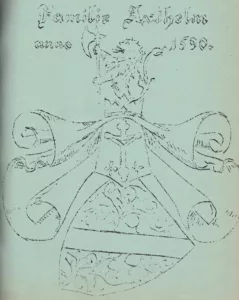 The origin story of this aforementioned coat of arms is briefly as follows:
The origin story of this aforementioned coat of arms is briefly as follows:
In the spring of 1913, a so-called “heraldist” appeared at the office of the government surveyor E. Axthelm in Dortmund, promising to provide all officials with their family coat of arms. Although the Dortmund namesake was very skeptical about this, he—like other officials—ordered the recommended family coat of arms and received a beautifully painted coat of arms with the following blazon (description):
“Blason of the Axthelm family coat of arms 1590:
The same can be found in the French heraldic work Armorial General , Vol. I, p. 90; family resident in Bavaria, Sweden [mistake!], Thuringia, and Westphalia. ( see under 3d )Coat of arms: In blue, a golden diagonal bar.
Decoration: A golden lion holding a silver halberd.
Coats: Blue and gold.
Meaning: Diagonal bar = homeland of the river (!), lion with halberd = bravery.
Karlsruhe, April 1, 1913. Signed Berthold Grosskopf . “
As “beautiful” as this coat of arms may appear at first glance, it is also incorrect. I therefore sent it (on May 16, 1933) to the Heraldic Society “Roland” in Dresden for evaluation and, in accordance with my comments, received a clear, objective critique, which read as follows:
“The coat of arms you sent us: a diagonal left bar on the shield, a double-tailed lion on the helmet , holding a battle axe in its paws, is very similar to the coat of arms of Ernst Gottlob Heinrich v. Axthelm, ennobled on April 13, 1814, and died in Nuremberg on May 10, 1833 ( Briefadeliges Gothaer Taschenbuch 1913), except that in the latter case, the diagonal left bar hovers within the shield. Further criticism of the changes: “A crown does not belong on a Gothic helmet, since there were no helmet crowns at that time; it is historically incorrect . Likewise, the entire position of the helmet and shield in relation to the helmet decoration is heraldically incorrect , for the former must be positioned to the side, just like the helmet decoration. This shows that this coat of arms was illegally borrowed and sold by an unscrupulous ‘heraldist’ and, moreover, was falsified by the unauthorized alteration.”
b) The misleading effect of the coat of arms of the Silesian noble family von Axleben .
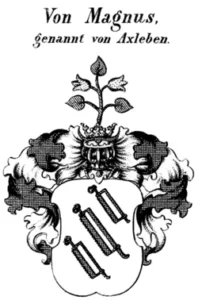
© Wikipedia
Years ago, this coat of arms was painted and sold for a good sum to an unsuspecting Axthelm family group in Kölleda by a so-called “coat of arms manufacturer,” a certain “coat of arms peddler.” Since some of these families ran a hardware store, this coat of arms, with its evocative image, seems to fit this family perfectly.
Unfortunately, this is one of the most serious offenses in the field of heraldry, committed by an imposter against the Axthelm family. This coat of arms is, down to the last detail, the legitimate coat of arms of the ancient, well-known Silesian noble family “von Axthelm,” called Magnus.
The enterprising mediator circumscribed this coat of arms by substituting the name “von Axtleben ” for the name “Axthelm,” casually placing this “family” in Silesia. Fortunately, some of the bearers (such as Fritz A. of Berlin) became aware of the situation and had the state-sworn herald Dr. Stephan Kekule von Stradonitz clarify the erroneous situation. This established that no bearer of the name Axthelm was entitled to bear this foreign coat of arms.
About this Silesian noble family can be found in Siebmacher’s Wappenbuch, Vol. II, 1 by O.T. von Hefner:
Von Axleben, called Magnus, Silesian noble family. Hermann, Hans, Theodor, Christoph, Royal Prussian Lieutenant Colonel (zD) – his adopted son : Gustav Julius Ludwig Andre, called von Axleben = Magnus. Evangelical Prussian nobility, Berlin, September 10, 1873. University Stable Master in Halle/S.
Coat of arms (1873): Within a red shield border, in silver, three black kettle hooks placed diagonally to the right. On the crowned helmet with black and silver pelmets, a three-leafed green plant with two tulip-like flowers.
c) The coat of arms of the Chief Forester Walther Axthelm
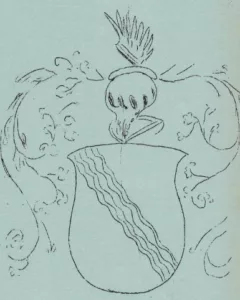 This coat of arms was made for Walther Axthelm, the son of teacher Alfons Alexander Axthelm, who was born in Eisenach and died in Vacha (Rhön) on February 9, 1927. Unfortunately, I can no longer verify who commissioned this namesake to create the coat of arms, or under what circumstances. I only possess the seal, which I received from the deceased’s wife.
This coat of arms was made for Walther Axthelm, the son of teacher Alfons Alexander Axthelm, who was born in Eisenach and died in Vacha (Rhön) on February 9, 1927. Unfortunately, I can no longer verify who commissioned this namesake to create the coat of arms, or under what circumstances. I only possess the seal, which I received from the deceased’s wife.
In any case, the coat of arms depicts a river within the shield. The interpretation is completely unclear to me, as this family originates from Olbersleben in Thuringia, which is crossed only by a village stream. Presumably, this coat of arms is also meant to indicate that the Axthelm family came to Germany from Sweden by water. This would be further evidence of the widespread prevalence of the “Swedish legend.”
The wing as a crest refers to the forestry profession. From a heraldic perspective, there is nothing wrong with this coat of arms; however, historically, it is considered a product of the imagination.
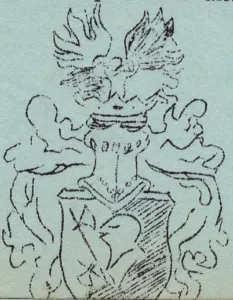 I occasionally came across this coat of arms shown here in an Axthelm family description, the origin of which could no longer be determined. It was described as: Coat of arms of the Royal Prussian Riflemen Axthelm and is a descriptive coat of arms, namely two battle axes and a helmet in the shield. In any case, this coat of arms must be considered an arbitrary product.
I occasionally came across this coat of arms shown here in an Axthelm family description, the origin of which could no longer be determined. It was described as: Coat of arms of the Royal Prussian Riflemen Axthelm and is a descriptive coat of arms, namely two battle axes and a helmet in the shield. In any case, this coat of arms must be considered an arbitrary product.
d) The coat of arms of the Bavarian noble line of Axthelm
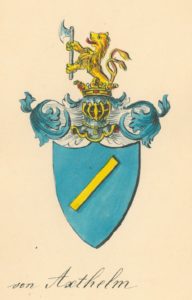 This coat of arms is the sole legal property of the Bavarian noble family von Axthelm. The fact that this coat of arms was unhesitatingly handed over to a commoner namesake by a so-called heraldist is proof of the unscrupulousness of the coat of arms law.
This coat of arms is the sole legal property of the Bavarian noble family von Axthelm. The fact that this coat of arms was unhesitatingly handed over to a commoner namesake by a so-called heraldist is proof of the unscrupulousness of the coat of arms law.
“Alperstedt near Erfurt, Germany, June 7, 1928.
To Mr. Albert Axthelm, Erfurt.Dear Sir,
I have received your letter of 4 June and, in reply,
I inform you: I found the coat of arms delivered to Mr. A. Axthelm in Coburg in 1921 in the Belgian work Armorial général by J.B. Rietstap , Vol. I, page 20, where the following text is noted in French:Axthelm – Baviere ( reconnaissance de noblesse , 13 April 1814).
D’azur à une cotice alésée d’or , pose en barre .
lasque couronne . limiers : un lion issant d’or , tenant one hache d’armes d’argent .
Lambrequins: d’argent et d’azur .English:
Axthelm – Bavaria (recognition of nobility on April 12, 1814).In a blue field, a golden, slanted bar (or diagonal left thread).
Crowned helmet.Cresting: A growing golden lion, holding a silver halberd in front of it.
Helmet covers: blue-silver.
I can provide you with information to this extent. Perhaps the Munich State Library can help you further. I would advise you to contact the painter and heraldist Lor. M. Rheude in Munich, referring to me.
sincerely
Edm. A. Koch, teacher and heraldist.”
This letter was sent to Albert, the Coburg namesake, as a cover letter by the above-mentioned heraldist, although I would like to emphasize that the namesake bears no responsibility whatsoever ; he could not have known when the heraldist handed him the coat of arms.
As I already emphasized in Report 1, this coat of arms is the only heraldically sound and legally permissible coat of arms within the Axthelm family, but only members of this ennobled line are entitled to bear it. Anyone who unlawfully appropriates this coat of arms violates Section 16 II 9 ALR, the General Law for the Prussian States of 1794, which states:
“No one may use a noble family coat of arms that does not belong to the family to which this coat of arms has either been expressly assigned or which has used it since ancient times .”
Further details on criminal liability are contained in § 1440a-C. II 20 ALR:
“Anyone who uses another’s family name or coat of arms to commit fraud shall be punished with the ordinary penalty of aggravated fraud, and this shall be made public as compensation for the offended family. Anyone who uses another’s family name or coat of arms, even without lawful intent, shall be prohibited from such presumption by imposing an arbitrary but severe fine, and this penalty shall actually be imposed on them in the event of a violation.”
Judging from the current legal situation, any legitimate bearer of this Bavarian coat of arms can take legal action against the unauthorized use of their family coat of arms by a foreigner, according to the established jurisprudence of the Imperial Court, applying Section 12 of the German Civil Code (protection of the right to a name) analogously (injunction!). However, criminal protection is only granted to the emblem of sovereignty and official coats of arms.
If I’m discussing this legal question here, it’s not because I suspect this or that namesake of unjustifiably claiming a coat of arms, but rather so that all namesakes should be somewhat informed about these legal matters in the area of coats of arms. I assume that most have already pondered such questions without finding an answer.
I would like to add at this point that the use of a modified coat of arms is also not permissible if this modified coat of arms has the same shield design and the same crest, even if all other components (such as the helmet, helmet mantles, shape of the shield, etc.) have been fundamentally changed. The core of a coat of arms is always the shield with the shield design. One is only authorized to use the coat of arms of a family of the same name if research has clearly established descent from the first bearer of the coat of arms. [For example, I am descended from the same ancestor as the commander of the Herm . Göring Regiment, Lieutenant Colonel Walther von Axthelm, but this common ancestor is the grandfather of the first bearer of the coat of arms. Relationship prior to the first bearer of the coat of arms is irrelevant. Therefore, it is clear that I have no right whatsoever to use this coat of arms. This Bavarian line von Axthelm embarked on a completely unique path of development with Johann Andrä (see Report 1) and the rise of his son Ernst Gottlob Heinrich!
I am convinced that every namesake is both humble and proud enough not to want to take credit for someone else’s work. So far, I have not met a single person who has even expressed the idea of claiming this Bavarian coat of arms for themselves. We all agree that the pre-eminence of the Bavarian noble line is one gloriously earned by the bearers of this nobility, and we are delighted with this honor for our cousin line.
But I also know, based on my correspondence with Lieutenant Colonel Walther von Axthelm, that this namesake in the noble rank remembers with reverence his peasant ancestors, who from ancient times , as far back as I can remember, consistently occupied an honorable, leading position as free farmers and farm owners.
This brings me to the foundation of a new peasant coat of arms.
-
The new farmer coat of arms
a) Basic questions about coat of arms adoption
The right to adopt and use a coat of arms for oneself and the members of one’s family as a symbol of blood community is indisputable, as long as no third-party rights are violated. However, it is also certain that coats of arms were originally only used by the nobility (landed nobility), communities (monasteries, cities, etc.), and burghers, etc., who, due to their social status, were often in a position to seal and issue documents . However, it is proven that the vast majority of burgher families did not use such a seal. Therefore, the greatest caution is required towards signets, coats of arms, and seals that, according to oral tradition, have only been in the family’s possession “since time immemorial.” I warn especially against the so-called coat of arms factories, ie the many heraldic offices and the itinerant coat of arms painters who usually present the uninformed with a fantasy or foreign coat of arms, which is provided with a partially or completely fictitious proof of origin or even with no proof of origin at all (as unfortunately several namesakes have already been cheated in this way or provided with meaningless coats of arms).
At present, every person of German blood is free to adopt a family coat of arms , provided that he has clearly proven his German blood .
What is a coat of arms anyway?
“Conceptually, the coat of arms, which was initially only a symbolic identification mark of the free warrior or the symbol of power of the prince and dynast, has slowly expanded over the centuries into the concept we have today of a coat of arms. Coats of arms are colorful, hereditary, or permanent symbols of a family or community with symbolic significance, represented based on medieval defensive weapons (shield and helmet with crest and crest). This definition encompasses everything that is generally considered a coat of arms today. These are primarily the family coats of arms of noble and non-noble families, the coats of arms of states and municipalities, as well as other legal entities and communities, such as ecclesiastical orders, medieval tournament societies, and clubs.”
How did the coat of arms come about?
“The origin of heraldic symbols dates back to the middle of the 12th century. Since this time, we encounter heraldic symbols on seals; since the second half of this century, there are also written records of the existence of heraldic symbols. If some people assume an even greater age for coats of arms, this is because the term ‘coat of arms’ is too broadly defined.
Heraldic symbols arose from the need to distinguish a warrior, who was unrecognizable in battle due to the completeness and similarity of his armor, by means of symbols visible from afar. The shield offered the most suitable surface for this, all the more so since it was already sacred to the Germanic peoples. The essential affinity of the coat of arms, developed in later heraldic times, with the Old German shield is based less on the similarity of the shield shape or the shield painting than on the intrinsic symbolic value that the shield, whether painted or unpainted, had enjoyed among the Germanic peoples since ancient times. It was the symbol of personal honor and thus emerged as the main component of the coat of arms, which enjoyed the same honor.
There is no connection between heraldry and runes . On the other hand, the house mark is similar to the ancient Germanic rune; and thus, it is still possible that house marks used in the creation of a coat of arms originated from a rune in individual cases” (cf. v. Ulmenstein, Ursprung und Entstehung des Wappenwesens , Weimar 1935).
What is a house mark?
“House marks are a parallel phenomenon to coats of arms. However, they are fundamentally not family symbols, but personal symbols . Only the basic form has often been passed down through several generations in families. House marks are used as seals, affixed to houses and farms as a mark of ownership, branded into livestock; they often mark the owner’s tools (see axe handle!).
The origin of the house mark must – purely linguistically speaking – lie in peaceful possession, whereas the coat of arms is closely linked to the art of war. The house mark – often also called the court mark – dates back to prehistoric times, is widespread throughout Germany, and is often still in use today. In terms of its external form, the house mark is a geometric figure formed only by the addition of lines. Unlike a coat of arms, color does not distinguish it. The house mark was often used as a heraldic figure; In this case, it receives the heraldic colors and is invariably placed on a shield” (Gustav Homeyer’s work, Die Haus- und Hofmarken (The House and Court Marks) , Berlin 1870, is still indispensable for the study of house marks today; a more recent, comprehensive treatment of this subject does not exist). The difference between house marks and coats of arms is clearly shown in Winkelmüller’s essay on the house marks and family coats of arms of the city of Hanover in the Hannoversche Geschichtsblätter (New Series), Vol. 2, Issues 5/6, Hanover 1933).
Our implement name Axthelm = axe handle can undoubtedly be traced back to such a house or farm mark. After all research (see Report 2 ), I can say with some certainty that our name in its current meaning already existed in the 10th century and was most likely directly related to a house mark. Therefore, in my opinion, the only way to acquire a new family coat of arms is to start with this house mark, place it as a shield image on an early Gothic shield (appropriate to the period), and create a simple peasant coat of arms from it. This coat of arms is recognizable as a peasant coat of arms in the early Gothic style by its early Gothic bucket helmet, still closed helmet covers, and two buffalo horns or bull horns. Similar peasant coats of arms appeared as early as the late 13th and early 14th centuries. During the Middle Ages, they remained very rare; later, they were more common only in Lower Saxony, Friesland, and Switzerland. Most farmers simply had house marks instead of coats of arms, and later, heraldic house marks, i.e., house marks transformed into a coat of arms. The shield images and helmet decorations of peasant coats of arms often allude to the owner’s occupation. These considerations guided me when I designed the following peasant coat of arms of the Axthelm family.
- b) The new farmer coat of arms of the Axthelm family (a draft).
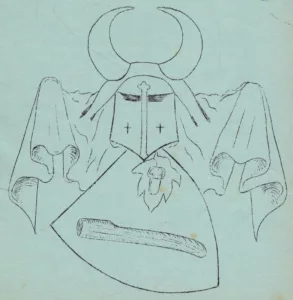
Draft of farmers coat of arms 1938
I designed this coat of arms under the following conditions: The coat of arms is to be a peasant crest. The etymological research of the name Axthelm ( see report 2 ) has clearly shown that our name can be traced back to the name of an implement and means “axe handle”. This is also the basis of the family line. This house mark, an axe handle , is therefore the distinguishing mark of our family and must therefore be the image of the shield. The acorn in the right corner of the shield is meant to indicate the land and forest ownership of the old farmers family. The Gothic bucket helmet and the Gothic shape of the shield, including the still closed helmet covers , indicate that I date the origins of the Axthelm family to before the beginning of the 13th century. The horns (as a helmet decoration ) are meant to symbolize the old farming line.
-
Authorization to use this coat of arms:
It is my sincere desire to unite all bearers of the name Axthelm into a unified family community by tracing them back to the original lineage of our family. This and nothing else is the goal of my repeated circular. This union of our family shall receive its external, documentary character through the visible, pictorial representation of our old German name. This is what this new peasant coat of arms is intended to achieve. Therefore, it is my wish that every bearer of this name, including female namesakes, even those who bear a different name due to marriage, bear this coat of arms as a seal of their membership in our family. This can only happen, however, once final approval to bear this coat of arms has been granted, which I await daily. To avoid any discrepancies or even unwanted falsifications, and to ensure that the exact, uniform design is maintained, I make the only condition that anyone who intends to use this coat of arms (which is, after all, a matter of honor!) comes to an agreement with me. I emphasize, however, that I do not intend to derive any advantage from it, but that, if at all possible, every namesake should acquire the coat of arms at no cost to them.
“Blessed is he who remembers his fathers with pleasure,
who rejoices in their deeds, in their greatness
entertains the listener and quietly rejoices
at the end of this beautiful series comes to a close!”
(Johann Wolfgang von Goethe)
[See original document on top for bibliography]
Click here for the today valid coat of arms of the Axthelm family


 Deutsch
Deutsch